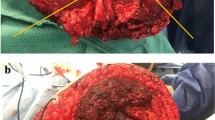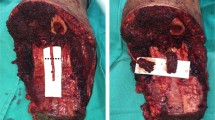Abstract
Purpose of Review
The goal of this paper is to review the current literature on targeted muscle reinnervation (TMR). This procedure has been developed over the past decade and has the potential to create intuitive and rapid control of prosthetics while also treating phantom limb and residual limb pain.
Recent Findings
In 2019, two major articles changed the way we understand the effects of the procedure. One was a randomized control trial by Dumanian et al. (Annals of Surgery 270(2):238–246, 2019) that showed that TMR improved phantom limb pain to a statistically significant degree. The other was a well-designed study by Valerio et al. (Journal of the American College of Surgeons 228(3):217–226, 2019) that revealed the incredible power of performing TMR at the time of amputation. Another article by Chang et al. (Plastic and reconstructive surgery 148(2):376–386, 2021) published in 2021 found that TMR improves ambulation rates when compared to standard treatment.
Summary
TMR is a well-studied operation that will not only treat residual and phantom limb pain, reduce opioid dependence, and improve ambulation, but also has the potential to foster intuitive control of prosthetics.
Similar content being viewed by others
References
Papers of particular interest, published recently, have been highlighted as: • Of importance •• Of major importance
Limb Loss Statistics - Amputee Coalition. Accessed August 15, 2021. https://www.amputee-coalition.org/limb-loss-resource-center/resources-filtered/resources-by-topic/limb-loss-statistics/limb-loss-statistics/#1
Sobti N, Park A, Crandell D, et al. Interdisciplinary care for amputees network: a novel approach to the management of amputee patient populations. Plast Reconstr Surgery Glob Open. 2021;9(2):e3384. https://doi.org/10.1097/gox.0000000000003384.
Bogdasarian RN, Cai SB, Tran BNN, Ignatiuk A, Lee ES. Surgical prevention of terminal neuroma and phantom limb pain: a literature review. Arch Plast Surg. 2021;48(3):310. https://doi.org/10.5999/APS.2020.02180.
Sachs M, Bojunga J, Encke A. Historical evolution of limb amputation. World J Surg. 1999;23(10):1088–93. https://doi.org/10.1007/s002689900628. Accessed on 15 Aug 2021
Robinson KP. Historical aspects of amputation. In: Annals of the Royal College of Surgeons of England. Vol 73. Royal College of Surgeons of England; 1991:134–136. Accessed April 24, 2021. https://www.ncbi.nlm.nih.gov/pmc/articles/PMC2499312/
Bowen JB, Wee CE, Kalik J, Valerio IL. Targeted muscle reinnervation to improve pain, prosthetic tolerance, and bioprosthetic outcomes in the amputee. Adv Wound Care. 2017;6(8):261–7. https://doi.org/10.1089/wound.2016.0717.
Kuiken TA, Dumanian GA, Lipschutz RD, Miller LA, Stubblefield KA. The use of targeted muscle reinnervation for improved myoelectric prosthesis control in a bilateral shoulder disarticulation amputee. Prosthetics Orthot Int. 2004;28(3):245–53. https://doi.org/10.3109/03093640409167756.
Kuiken TA, Li G, Lock BA, et al. Targeted muscle reinnervation for real-time myoelectric control of multifunction artificial arms. JAMA. 2009;301(6):619–28. https://doi.org/10.1001/JAMA.2009.116. Accessed on 24 Aug 2021
Kuiken TA, Miller LA, Lipschutz RD, et al. Targeted reinnervation for enhanced prosthetic arm function in a woman with a proximal amputation: a case study. Lancet (London, England). 2007;369(9559):371–80. https://doi.org/10.1016/S0140-6736(07)60193-7.
Hart SE, Kung TA. Novel approaches to reduce symptomatic neuroma pain after limb amputation. Curr Phys Med Rehabil Rep. 2020;8(3):83–91. https://doi.org/10.1007/S40141-020-00276-2.
•• Dumanian GA, Potter BK, Mioton LM, et al. Targeted muscle reinnervation treats neuroma and phantom pain in major limb amputees: a randomized clinical trial. Ann Surg. 2019;270(2):238–46. https://doi.org/10.1097/SLA.0000000000003088. (This was the first randomized controlled trial that evaluated any treatment for neuroma. TMR was found to improve phantom limb pain in amputee patients.)
Mioton LM, Dumanian GA, Shah N, et al. Targeted muscle reinnervation improves residual limb pain, phantom limb pain, and limb function: a prospective study of 33 major limb amputees. Clin Orthop Relat Res. 2020;478(9):2161–7. https://doi.org/10.1097/CORR.0000000000001323.
O’brien AL, Jordan SW, West JM, Mioton LM, Dumanian GA, Valerio IL. Targeted muscle reinnervation at the time of upper-extremity amputation for the treatment of pain severity and symptoms. J Hand Surg. 2021;46:72.e1-72.e10. https://doi.org/10.1016/j.jhsa.2020.08.014.
Alexander JH, Jordan SW, West JM, et al. Targeted muscle reinnervation in oncologic amputees: early experience of a novel institutional protocol. J Surg Oncol. 2019;120(3):348–58. https://doi.org/10.1002/jso.25586.
Frantz TL, Everhart JS, West JM, Ly TV, Phieffer LS, Valerio IL. Targeted muscle reinnervation at the time of major limb amputation in traumatic amputees. JBJS Open Access. 2020;5(2):e0067–e0067. https://doi.org/10.2106/jbjs.oa.19.00067.
Bowen JB, Ruter D, Wee C, West J, Valerio IL. Targeted muscle reinnervation technique in below-knee amputation. Plast Reconstr Surg. 2019;143(1):309–12. https://doi.org/10.1097/PRS.0000000000005133.
Valerio I, Schulz SA, West J, Westenberg RF, Eberlin KR. Targeted muscle reinnervation combined with a vascularized pedicled regenerative peripheral nerve interface. Plast Reconstr Surg Glob Open. 2020;8(3):e2689. https://doi.org/10.1097/gox.0000000000002689.
Agrawal NA, Gfrerer L, Heng M, Valerio IL, Eberlin KR. The use of peripheral nerve stimulation in conjunction with TMR for neuropathic pain. Plast Reconstr Surg Glob Open. 2021; 9(6). https://doi.org/10.1097/GOX.0000000000003655
Grome LJ, Agrawal NA, Wang E, Netscher DT. Targeted muscle reinnervation for symptomatic neuromas utilizing the terminal anterior interosseous nerve. Plast Reconstr Surg Glob Open. 2020;8(7). https://doi.org/10.1097/GOX.0000000000002979
Woo SL, Urbanchek MG, Cederna PS, Langhals NB. Revisiting nonvascularized partial muscle grafts: a novel use for prosthetic control. Plast Reconstr Surg. 2014; 134(2):344e-346e. https://doi.org/10.1097/PRS.0000000000000317. PMID: 25068369.
Woo SL, Urbanchek MG, Zheng X, Leach MK, Moon JD, Cederna PS, Langhals NB. Partial Skeletal Muscle Grafts for Prosthetic Control, Plast Reconstr Surg. 2014; 134(4S-1): 55-56. https://doi.org/10.1097/01.prs.0000455396.91552.19
Hooper RC, Cederna PS, Brown DL, Haase SC, Waljee JF, Egeland BM, Kelley BP, Kung TA. Regenerative Peripheral Nerve Interfaces for the Management of Symptomatic Hand and Digital Neuromas, Plast Reconstr Surgery Glob Open. 2020; 8(6):e2792. https://doi.org/10.1097/GOX.0000000000002792
• Kubiak CA, Kemp SWP, Cederna PS, Kung TA. Prophylactic regenerative peripheral nerve interfaces to prevent postamputation pain. Plast Reconstr Surg. 2019;144(3):421e–30e. https://doi.org/10.1097/PRS.0000000000005922. (Prophylactic regenerative peripheral nerve interfaces to prevent postamputation pain.•)
Bhashyam AR, Liu Y, Kao DS. Targeted Peripheral Nerve Interface: Case Report with Literature Review, Plast Reconstr Surgery Glob Open. 2021;9(4):e3532. https://doi.org/10.1097/GOX.0000000000003532
Kurlander DE, Wee C, Chepla KJ, Lineberry KD, Long TC, Gillis JA, Valerio IL, Khouri JS. TMRpni: Combining Two Peripheral Nerve Management Techniques, Plast Reconstr Surgery Glob Open. 2020; 8(10):e3132. https://doi.org/10.1097/GOX.0000000000003132
•• Valerio IL, Dumanian GA, Jordan SW, et al. Preemptive treatment of phantom and residual limb pain with targeted muscle reinnervation at the time of major limb amputation. J Am Coll Surg. 2019;228(3):217–26. https://doi.org/10.1016/j.jamcollsurg.2018.12.015. (This was the first controlled study to show good results when preemptively treating phantom and residual limb pain with TMR at the time of amputation.)
Cheesborough JE, Souza JM, Dumanian GA, Bueno RA. Targeted Muscle Reinnervation in the Initial Management of Traumatic Upper Extremity Amputation Injury. HAND. 2014;9(2):253-257. https://doi.org/10.1007/s11552-014-9602-5
Kim PS, Ko JH, O’Shaughnessy KK, Kuiken TA, Pohlmeyer EA, Dumanian GA. The effects of targeted muscle reinnervation on neuromas in a rabbit rectus abdominis flap model. J Hand Surg. 2012; 37(8):1609–16. https://doi.org/10.1016/J.JHSA.2012.04.044
• Chang BL, Mondshine J, Attinger CT, et al. Targeted muscle reinnervation improves pain and ambulation outcomes in highly comorbid amputees. Plast Reconstr Surg. 2021;148(2):376–86. https://doi.org/10.1097/PRS.0000000000008153. (First study to tie TMR with improved objective ambulation outcomes. Furthermore, this was done in high comorbidity patients such as diabetics and end stage renal disease patients)
Author information
Authors and Affiliations
Corresponding author
Ethics declarations
Conflict of Interest
Dr. Valerio serves as a consultant for Integra Lifesciences, Axogen, and Checkpoint Inc. Dr. Eberlin serves as a consultant for AxoGen, Integra, Checkpoint, and Tissium. Dr. Heng serves as a consultant for Zimmer-Biomet, Inc. No funds were received or utilized for the research reported in this article. Dr. Agrawal and Dr. Gfrerer have no financial interests to declare in relation to the content of this article.
Human and Animal Rights and Informed Consent
This article does not contain any studies with human or animal subjects performed by any of the authors.
Additional information
Publisher's Note
Springer Nature remains neutral with regard to jurisdictional claims in published maps and institutional affiliations.
This article is part of the Topical Collection on Amputation Rehabilitation
Rights and permissions
About this article
Cite this article
Agrawal, N., Gfrerer, L., Heng, M. et al. Targeted Muscle Reinnervation as a Surgical Approach for Phantom Limb Pain Management Following Amputation. Curr Phys Med Rehabil Rep 9, 200–206 (2021). https://doi.org/10.1007/s40141-021-00329-0
Accepted:
Published:
Issue Date:
DOI: https://doi.org/10.1007/s40141-021-00329-0




